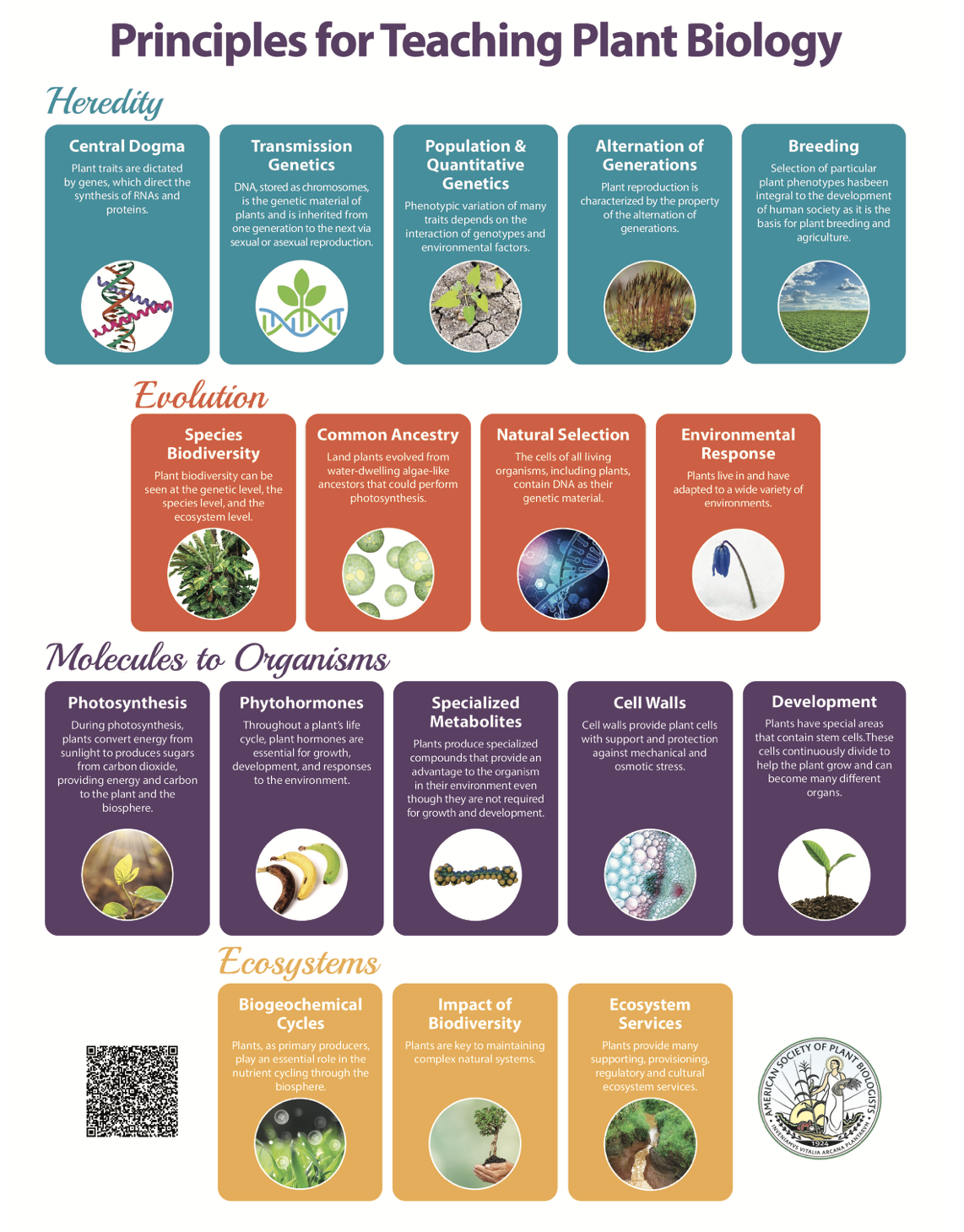Click Here for Teaching Resources
Evolution
- Species Biodiversity: Plant biodiversity can be seen at the genetic level, the species level, and the ecosystem level. Plants exhibit diversity in size and shape, ranging from tiny mosses to giant trees; there are ~350,000 species of plants today!
- Common Ancestry: Land plants evolved from water-dwelling algae-like ancestors that could perform photosynthesis.
- Natural Selection: The cells of all living organisms, including plants, contain DNA as their genetic material. Genetic variation is the foundation for natural selection as it results in diversity within a population.
- Environmental Response: Plants live in and have adapted to a wide variety of environments. Many plants have also co-evolved with microbes and animals.
Ecosystems
- Biogeochemical Cycles: Plants, as primary producers, play an essential role in the nutrient cycling through the biosphere.
- Impact of Biodiversity: Plants are key to maintaining complex natural systems. High biodiversity ensures greater ecological resilience in the face of ecological changes. Human activities can impact biodiversity which can further impact ecosystem health and associated ecosystem services.
- Ecosystem Services: Plants provide many supporting, provisioning, regulatory and cultural ecosystem services. For example, plants provide food, fiber, and medicines. Plants also play important roles in regulating global climate.
Heredity
- Central Dogma: Plant traits are dictated by genes, which direct the synthesis of RNAs and proteins. Because we can conduct controlled crosses with plants, plants have historically served as an excellent model to study genetic questions, such as how flower color is inherited.
- Transmission Genetics: DNA, stored as chromosomes, is the genetic material of plants and is inherited from one generation to the next via sexual or asexual reproduction. Plants inherit DNA from their parents and will therefore resemble their parents in phenotype.
- Population & Quantitative Genetics: Phenotypic variation of many traits depends on the interaction of genotypes and environmental factors. Plant populations can adapt to different environments through selection of phenotypic variants. Local adaptation is particularly important as plants are sessile and cannot move to more optimal conditions.
- Alternation of Generations: Plant reproduction is characterized by the property of the alternation of generations. This phenomenon has resulted in different modes of offspring distribution such as spores and seeds.
- Breeding: Selection of particular plant phenotypes has been integral to the development of human society as it is the basis for plant breeding and agriculture. Tracking changes in allelic diversity within a population allows plant breeders to observe natural selection and continue to improve crop productivity.
Molecules to Organisms
- Photosynthesis: During photosynthesis, plants convert energy from sunlight to produce sugars from carbon dioxide. These sugars provide both energy and the carbon skeleton to build more complex molecules required for growth. Photosynthesis provides the biosphere with food, energy, and oxygen.
- Phytohormones: Throughout a plant’s life cycle, plant hormones are essential for growth, development, and responses to the environment. Plant hormones control responses to external signals (such as light, gravity, and temperature), abiotic stresses (drought, nutrient), and biotic challenges (pathogens, herbivory).
- Specialized Metabolites: Plants produce specialized metabolites, compounds that are not essential for growth and development but that provide an advantage to the organism in their environment. Humans use plant secondary metabolites as pigments, medications, and flavorings.
- Cell Walls: Cell walls provide plant cells with support and protection against mechanical and osmotic stress. Cell walls can also provide fibers, fuel, and building materials for humans, insects, birds, and other organisms.
- Development: Plants have stem cells that are located in meristematic tissues. In contrast to animals, plant growth is driven by continuous growth from these stem cells, allowing for extraordinary developmental plasticity and the ability to generate new organs. In addition, most plant cells are totipotent – that is, they can give rise to an entire plant under the right conditions!
Downloadable Principles Resources


